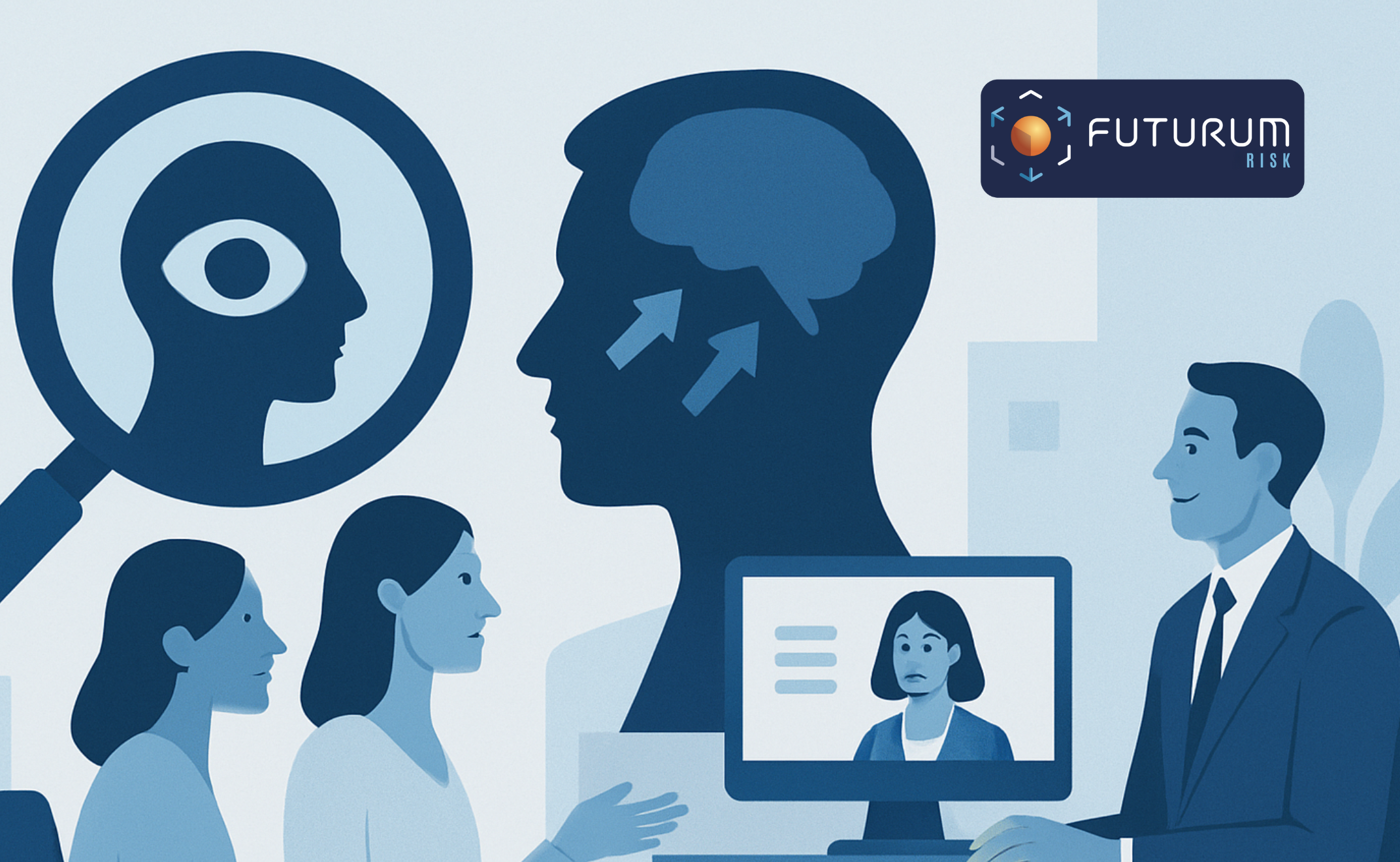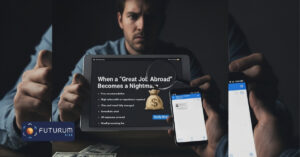Behavioural Detection, Interview Psychology, and What It Means for Employee Wellness
Following last week’s blog on behavioural detection, we continue with a more focused application, the psychology of interviewing. This is not about rehearsed Q&As or ticking HR boxes. It is about understanding people, in all their complexity, through careful conversation and observation.
Interviewing is one of the few structured opportunities you have to gain insight into how someone thinks, how they manage stress, and how they show up in moments of pressure. Hiring someone new or sitting down with a team member for a difficult conversation, how a person responds, through their words, tone, and body language, often reveals more than any report ever could.
Why Psychology Matters in Interviews
Most of us grow up believing that communication is mostly about what is said. In reality, most of it happens elsewhere. Professor Albert Mehrabian’s landmark research found that 55% of communication is non-verbal, 38% comes from tone of voice, and only 7% is conveyed through the words themselves.
In other words, what people say matters far less than how they say it and how they behave while saying it.
This has huge implications for anyone responsible for team integrity, staff wellbeing, or organisational risk. If you are paying attention to body language, tone, and behaviour, you will see things others miss, things that often signal risk, distress, or misalignment long before they show up in performance data or internal reporting.
Internal Interviews Are More Than Just Compliance
One of the most underused tools in a leader’s toolkit is the internal interview, not the kind used to discipline, but the kind used to understand. Beyond just identifying potential issues like fraud or conflict, behavioural detection in these internal interviews can also reveal signs of deeper stress or struggle.
Employees may not always voice when they are overwhelmed or dealing with personal challenges, but subtle changes in behaviour often give clues, a hesitant voice, guarded body language, or inconsistent eye contact, can indicate distress.
These signs aren’t simply red flags for risk, they are signals that someone might need support. Recognising this early means leaders can intervene in a way that promotes wellbeing and prevents burnout, which benefits both the individual and the organisation.
This approach moves the internal interview from a compliance exercise into a genuine conversation about people’s experiences, helping build trust and a healthier workplace culture. It’s this blend of insight and empathy, powered by behavioural observation, that transforms a simple conversation into a vital leadership tool.
A critical part of this process is understanding that how questions are asked matters just as much as the answers given. Rather than rushing to conclusions, a skilled interviewer creates a calm environment, asking open yet focused questions that encourage reflection rather than defensive responses.
The tone, pacing, and phrasing can either put the employee at ease or heighten their anxiety. Patience and silence after a response are powerful tools, allowing space for further disclosure. Observing inconsistencies between spoken words and non-verbal signals often reveals more than the answers themselves.
This subtle interplay between questioning technique and behavioural cues forms the foundation for effective internal interviewing, a nuanced skill that requires practice, awareness, and genuine care.
New Hires: Don’t Just Look for Confidence, Look for Authenticity
When hiring new employees, especially in roles that carry influence, access, or confidentiality, technical capability is only half the picture. You also want to know how a person handles discomfort.
An interview offers a controlled way to see how someone reacts when things do not go as expected. For example:
- A candidate may be confident in structured answers, but become evasive when asked to reflect on a mistake or failure.
- Someone may talk fluently about their experience, but emotionally disconnect when describing challenges they faced, suggesting a lack of self-awareness or emotional depth.
- You might notice overly rehearsed stories, which sound too perfect or polished, and may hide the real learning that came from the experience.
These cues are not reasons to exclude a candidate, but they are reasons to probe further. Real people have rough edges. They stumble, reflect, and adapt. Authenticity often shows itself not in flawless delivery, but in honest, thoughtful responses that show self-reflection.
In addition to observing behaviour, effective interviewing for new hires involves understanding the context behind those behaviours.
Candidates come from diverse backgrounds and experiences that shape how they communicate under pressure. Some may appear reserved, not because they lack confidence, but due to cultural norms or past experiences with authority figures.
Others may initially seem overly confident as a way to mask uncertainty. Recognising these nuances requires interviewers to balance instinct with empathy, asking questions that invite storytelling rather than simple yes or no answers.
This approach creates space for candidates to reveal their problem-solving abilities and values authentically. Over time, behavioural detection in interviews becomes less about spotting deception and more about interpreting human complexity, a crucial skill when building a resilient, trustworthy team that thrives beyond technical skills alone.
Behavioural Detection as a Wellness Tool
One of the most overlooked applications of behavioural detection is in support of employee wellness. Not every behaviour change is a sign of misconduct. In many cases, it is a sign of emotional strain.
A sharp, reliable employee who becomes withdrawn or vague may be going through something personal. A team member who over-explains basic tasks or reacts defensively to feedback may be overwhelmed. These are not reasons to reprimand someone, they are reasons to check in, to listen, and to offer support.
By learning how to read these behavioural shifts, managers can take action before mistakes happen or performance deteriorates. More importantly, they can show genuine care, which builds trust and loyalty across the team.
Recognising these subtle signs early creates an opportunity to intervene constructively, rather than reactively. It positions behavioural detection not just as a tool for risk management, but as a proactive approach to fostering a healthier workplace culture.
When employees feel seen and supported in their challenges, their well-being improves, and with it, their engagement and productivity. This holistic approach helps protect the business from avoidable disruptions while promoting an environment where people can thrive.
What to Look for: Expanding on Micro Behavioural Cues
Below are key areas to focus on during interviews, along with what different cues may indicate:
Facial cues
- Watch for facial expressions that do not match the tone of the conversation. A smile that appears forced or a blank expression when discussing something emotional can suggest discomfort.
- Rapid changes in expression, or a face that stays frozen or neutral for too long, may signal that someone is trying to mask their real response.
Autonomic nervous system cues
- Heavy breathing, flushed skin, or sweating can all be signs of stress, especially if the room is comfortable and there is no physical reason for the reaction.
- Enlarged pupils may indicate heightened arousal or anxiety, particularly when certain topics are raised.
Body language
- Shifts in posture, clenched hands, or sudden stillness can signal that someone is feeling threatened or under pressure.
- Repeated gestures, fidgeting, or unexplained movements may indicate nervousness or self-soothing behaviour.
Voice cues
- Listen for changes in pitch or volume. A raised pitch can signal anxiety, while a drop in volume might suggest reluctance or uncertainty.
- Sudden pauses, increased speed, or stumbling over words can be signs that someone is struggling to maintain composure.
Interactional style
- If someone repeatedly avoids direct answers, uses vague language, or shifts into the third person when describing their own actions, these may be signs of distancing behaviour.
- Repetition or tangents that include irrelevant details may signal that a person is buying time or distracting from a sensitive subject.
Content cues
- Pay attention to tense changes, such as switching from past to present, especially when describing actions or decisions.
- Stories that lack structure or feel overly complex can be a red flag, particularly if the person is usually articulate.
Understand Your Own Biases Too
No matter how well trained you are, cognitive bias affects everyone. Common biases that show up in interviews include:
- Confirmation bias, where you unconsciously seek information that supports what you already believe.
- Blind spot bias, where you assume others are more biased than you are.
- Selective perception, where your mood or expectations influence what you notice and what you ignore.
- Survivorship bias, where you only focus on those who succeeded, missing the patterns in those who did not.
- Ostrich effect, where you avoid uncomfortable information because acting on it may be inconvenient.
Being aware of your own filters is just as important as recognising someone else’s behavioural shifts.
Interviewing as a Human Skill
Interviewing is far more than a checklist or a formality, it is an opportunity to build a genuine connection and deepen understanding. When leaders apply behavioural detection thoughtfully, they uncover not only risks or red flags but also clues about how individuals are coping, growing, or struggling beneath the surface.
In today’s fast-paced and often unpredictable work environment, recognising these hidden signals supports not just better hiring decisions, but also proactive care for employee wellness. This dual focus helps create a workplace where people feel truly valued and safe to bring their whole selves to work.
Ultimately, the strength of any organisation depends on its people, their resilience, trust, and engagement. Behavioural detection empowers leaders to nurture these qualities, transforming interviews from mere assessments into meaningful conversations that safeguard both the individual and the business.





